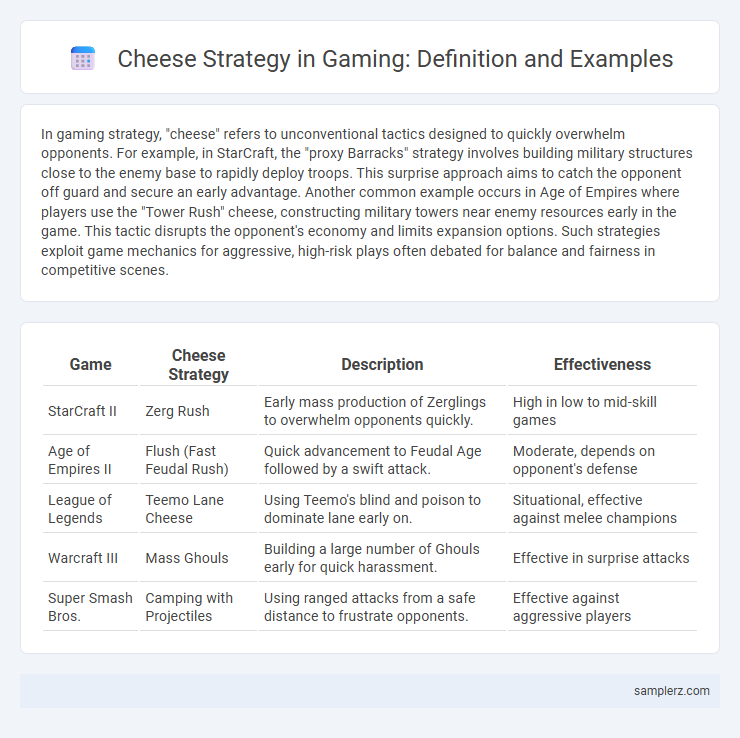In gaming strategy, "cheese" refers to unconventional tactics designed to quickly overwhelm opponents. For example, in StarCraft, the "proxy Barracks" strategy involves building military structures close to the enemy base to rapidly deploy troops. This surprise approach aims to catch the opponent off guard and secure an early advantage. Another common example occurs in Age of Empires where players use the "Tower Rush" cheese, constructing military towers near enemy resources early in the game. This tactic disrupts the opponent's economy and limits expansion options. Such strategies exploit game mechanics for aggressive, high-risk plays often debated for balance and fairness in competitive scenes.
Table of Comparison
| Game | Cheese Strategy | Description | Effectiveness |
|---|---|---|---|
| StarCraft II | Zerg Rush | Early mass production of Zerglings to overwhelm opponents quickly. | High in low to mid-skill games |
| Age of Empires II | Flush (Fast Feudal Rush) | Quick advancement to Feudal Age followed by a swift attack. | Moderate, depends on opponent's defense |
| League of Legends | Teemo Lane Cheese | Using Teemo's blind and poison to dominate lane early on. | Situational, effective against melee champions |
| Warcraft III | Mass Ghouls | Building a large number of Ghouls early for quick harassment. | Effective in surprise attacks |
| Super Smash Bros. | Camping with Projectiles | Using ranged attacks from a safe distance to frustrate opponents. | Effective against aggressive players |
Defining Cheese Strategies in Gaming
Cheese strategies in gaming exploit unorthodox or low-effort tactics to gain a quick advantage, such as spamming early rush units or exploiting map-specific chokepoints in real-time strategy games like StarCraft II. These tactics often rely on surprise and timing rather than balanced gameplay, forcing opponents to adapt quickly or suffer early defeat. Recognizing and countering cheese strategies is crucial for maintaining competitive integrity and advancing strategic depth.
Historical Origins of Cheese Tactics
Cheese tactics in gaming trace their roots back to early strategy games like StarCraft and Warcraft, where players exploited game mechanics to gain unfair advantages. These tactics often involved repetitive, low-skill strategies such as mass-producing a single unit type or spamming early rush attacks to overwhelm opponents quickly. Understanding the historical origins of cheese tactics reveals how they evolved from simple exploits into complex strategies influencing modern competitive gaming.
Classic Examples of Cheese Plays in RTS Games
Cheese tactics in RTS games like StarCraft often involve early-game aggressive strategies such as the Zerg Rush, where players flood opponents with weak units to overwhelm defenses quickly. Another classic example is the Protoss Cannon Rush, placing defensive structures inside an enemy's base to restrict expansion and force errors. These strategies exploit surprise and economy disruption, forcing players into defensive positions before they can execute standard macro play.
Famous Cheese Openings in StarCraft
Famous cheese openings in StarCraft include the Terran's 6-Pool Rush and the Zerg's Cannon Rush, both designed to overwhelm opponents early. These strategies exploit quick unit production and surprise attacks, forcing defenders into defensive postures. Mastery of such cheese tactics can disrupt standard gameplay and secure rapid victories.
Cheese Strategies in MOBAs: Notable Instances
Cheese strategies in MOBAs, such as surprise early ganks or unconventional hero picks, exploit opponents' expectations for quick victories. Notable examples include the aggressive push tactics with heroes like Pugna in Dota 2, overwhelming enemies before they can adequately respond. These tactics rely on exploiting game mechanics and map control to secure early dominance and disrupt standard gameplay rhythms.
Unexpected Cheese in Fighting Games
Unexpected cheese in fighting games often involves exploiting obscure character moves or stage glitches to gain unfair advantages, such as using invincible recovery frames or endless combos that catch opponents off guard. Techniques like Zangief's instant jump SPD or teleport frame traps in Street Fighter exemplify this strategy, disrupting standard match flow and forcing opponents into defensive play. These tactics highlight the importance of adaptability and in-depth game knowledge in competitive fighting game tournaments.
Risk and Reward: When Cheese Pays Off
In gaming, cheese strategies often involve exploiting game mechanics to gain disproportionate advantages with minimal investment, exemplified in titles like StarCraft where early rush tactics can overwhelm opponents before they develop. Risk and reward are balanced as such strategies can lead to swift victories if successful but leave players vulnerable if countered, highlighting the strategic gamble inherent in cheese plays. Understanding when cheese pays off requires assessing opponent tendencies and game state, maximizing potential rewards while mitigating the high risk of failure.
Famous Pro Player Cheese Moments
Famous pro player cheese moments in gaming strategy often involve unexpected tactics that catch opponents off guard, such as Flash's proxy barracks in StarCraft II which disrupted his opponent's economy. Another notable example is Boxer's early rush in StarCraft: Brood War, leveraging swift unit production to overwhelm the enemy before they could prepare defenses. These high-level cheese strategies highlight the importance of surprise and timing in competitive gameplay.
Countering Common Cheese Tactics
Countering common cheese tactics in gaming requires recognizing patterns such as early rushes, unexpected unit builds, or aggressive map control. Employing early scouting methods like sending units to key choke points or deploying detection abilities can reveal enemy intentions ahead of time. Adaptations such as bolstering defenses with walls, building anti-rush units, or adjusting resource allocation ensure a strong response to cheese strategies and maintain strategic advantage.
The Ethical Debate: Is Cheese Legitimate Play?
Cheese tactics in gaming refer to exploiting specific strategies or game mechanics to achieve easy wins, such as repeatedly spamming a powerful unit or taking advantage of unbalanced map positions. This practice sparks ethical debates, as some players view cheese as clever skill and creativity, while others consider it unsportsmanlike and detrimental to competitive integrity. The legitimacy of cheese often depends on community standards, game design intentions, and whether developers explicitly address such strategies through patches or balance updates.

example of cheese in strategy Infographic
 samplerz.com
samplerz.com